American singer, actress, and vaudevillian Judy Garland (1922-1969) was one of the brightest, most tragic film stars of Hollywood's Golden Era. During a career that spanned 45 of her 47 years, Garland attained international stardom as an actress in musicals and dramas, with her records, and on the concert stage. She was nominated for the Oscar for Best Actress for A Star is Born (1954) and received a nomination for Best Supporting Actress for Judgment at Nuremberg (1961). With her warmth, spirit, and rich and exuberant voice, Garland entertained devoted theatregoers with various musicals.
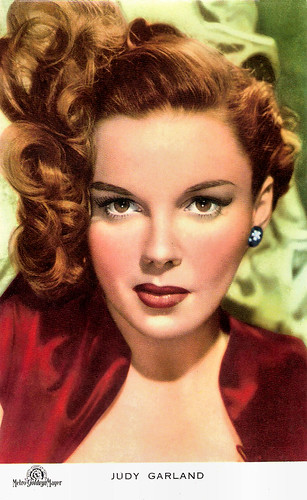
Belgian postcard by S.A. Victoria, Brussels, no. 639. Photo: Metro-Goldwyn-Mayer.
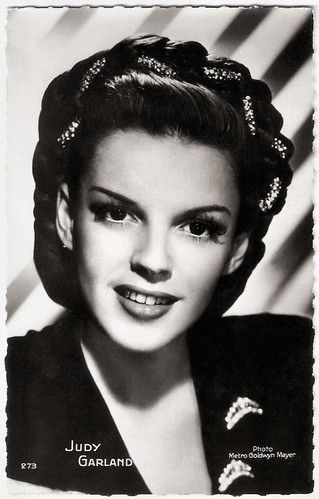
French postcard by Editions P.I., Paris, no. 273. Photo: Metro-Goldwyn-Mayer, 1950.
Judy Garland was born Frances Ethel Gumm in 1922 in Grand Rapids, Minnesota, U.S. She was the youngest daughter of vaudevillians Ethel Marion (Milne) and Francis Avent Gumm. Only two, Garland began performing in vaudeville with her two older sisters Mary Jane Gumm and Virginia Gumm as 'The Gumm Sisters'. Her family life was not a happy one, largely because of her mother's drive for her to succeed as a performer and also her father's closeted homosexuality. The Gumm family would regularly be forced to leave town owing to her father's illicit affairs with other men, and from time to time they would be reduced to living out of their automobile.
Her mother took Frances out of The Gumm Sisters act and together they travelled across America where she would perform solo in nightclubs, cabarets, hotels and theatres. In 1935, Frances was signed by Louis B. Mayer, mogul of leading film studio MGM, after hearing her sing. Her name was changed from Frances Gumm to Judy Garland, after a popular 1930s song 'Judy' and film critic Robert Garland. Tragedy followed two months later when her father died of meningitis in November 1935.
Having been given no assignments except for singing on the radio, Judy faced the threat of losing her job following the arrival of Deanna Durbin. Knowing that they couldn't keep both of the teenage singers, MGM devised a short entitled Every Sunday (Felix E. Feist, 1936) which would be the girls' screen test. Judy was the outright winner and MGM kept her. Durbin moved to Universal. Judy's film debut was in Pigskin Parade (David Butler, 1936), in which she played a teenage hillbilly.
Her career officially started when she sang one of her most famous songs, 'You Made Me Love You', at Clark Gable's birthday party in February 1937. Louis B. Mayer finally paid attention to the talented songstress, and MGM set to work preparing various musicals with her. All the work on these musicals took its toll on the young teenager, and she was given numerous pills by the studio doctors to combat her tiredness on set. Another problem was her weight fluctuation, but she was soon given amphetamines to give her the desired streamlined figure. This would produce the downward spiral that resulted in her lifelong drug addiction.
In 1939, Judy shot to stardom with The Wizard of Oz (Victor Fleming, 1939), in which she portrayed Dorothy, an orphaned girl living on a farm in the dry plains of Kansas who gets whisked off into the magical world of Oz on the other end of the rainbow. Her poignant performance and sweet delivery of her signature song, 'Over The Rainbow', earned Judy a special juvenile Oscar statuette in 1940 for Best Performance by a Juvenile Actor.
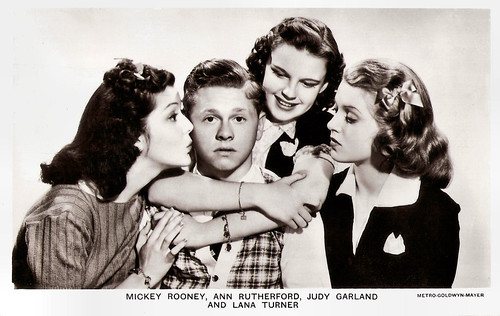
British postcard in the Picturegoer Series, London, no. 1281. Photo: Metro-Goldwyn-Mayer. Publicity still for Love Finds Andy Hardy (George B. Seitz, 1938) with Mickey Rooney, Ann Rutherford, Judy Garland and Lana Turner.
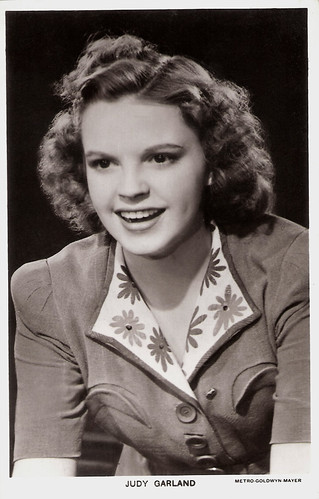
British postcard in the Picturegoer Series, London, no. 1178b. Photo: Metro-Goldwyn-Mayer.

Dutch postcard, no. 3114. Photo: MGM. Publicity still for Ziegfeld Girl (Robert Z. Leonard, Busby Berkeley, 1941) with Hedy Lamarr and Lana Turner.
Judy Garland was now taking an interest in men. After starring in her final juvenile performance in Ziegfeld Girl (Robert Z. Leonard, Busby Berkeley, 1941) alongside glamorous beauties Lana Turner and Hedy Lamarr, Judy got engaged to bandleader David Rose in May 1941, just two months after his divorce from Martha Raye. Despite planning a big wedding, the couple eloped to Las Vegas and married with just her mother Ethel and her stepfather Will Gilmore present. However, their marriage went downhill as, after discovering that she was pregnant in November 1942, David and MGM persuaded her to abort the baby to keep her good-girl image up. She did so and, as a result, was haunted for the rest of her life by her 'inhumane actions'. The couple separated in January 1943.
Garland made more than two dozen films with MGM, nine with Mickey Rooney. She played a vaudevillian during WWI in For Me and My Gal (Busby Berkeley, 1942). A big success was Meet Me in St. Louis (Vincente Minnelli, 1944), Director Vincente Minnelli highlighted Judy's beauty for the first time on screen, having made the period musical in colour. He showed off her large brandy-brown eyes and her full, thick lips and after filming ended in April 1944, a love affair resulted between director and actress and they were soon living together.
Vincente began to mould Judy and her career, making her more beautiful and more popular with audiences worldwide. He directed her in The Clock (Vincente Minnelli, 1945), and during filming the couple announced their engagement. On 15 June 1945 Judy and Vincente married at her mother's home with her boss Louis B. Mayer giving her away and her best friend Betty Asher serving as bridesmaid. After their honeymoon in New York, Judy discovered that she was pregnant. Her first film after marrying Vincente Minnelli was The Harvey Girls (Vincente Minnelli, 1946). Then Judy gave birth to their daughter, Liza Minnelli. After a postnatal depression, she spent much of her time recuperating in bed.
She returned to work, to film The Pirate (Vincente Minnelli, 1948) with Gene Kelly. Judy's mental health was deteriorating and she began hallucinating things and making false accusations toward people, especially her husband, making the filming a nightmare. She then teamed up with Fred Astaire for the musical Easter Parade (Charles Walters, 1948), which resulted in a successful comeback despite having Vincente fired from directing the musical. Afterwards, Judy's health deteriorated and she began the first of several suicide attempts. In May 1949, she was checked into a rehabilitation centre, which caused her much distress. After being replaced by Betty Hutton on Annie Get Your Gun (George Sidney, 1950), Judy was suspended before making her final film for MGM, Summer Stock (Charles Walters, 1950). Then Judy received her third suspension and was fired by MGM, and her second marriage was soon dissolved.
Having taken up with ruggedly handsome and streetwise entrepreneur Sidney Luft, Judy travelled to London to star at the legendary Palladium. She was an instant success and after her divorce to Vincente Minnelli was finalised on 29 March 1951 after almost six years of marriage, Judy travelled with Sid to New York to make an appearance on Broadway. With her newfound fame on stage, Judy was stopped in her tracks in February 1952 when she became pregnant by Sid Luft. At the age of 30, she made him her third husband. Her relationship with her mother had long since been dissolved by this point, and after the birth of her second daughter, Lorna Luft, on 21 November 1952, she refused to allow her mother to see her granddaughter. Ethel then died in January 1953 of a heart attack, leaving Judy devastated and feeling guilty about not reconciling with her mother before her untimely demise.

Belgian Collectors Card by Kwatta, Bois d'Haine, no. C. 101. Photo: Metro-Goldwyn-Mayer. Collection: Geoffrey Donaldson Institute.
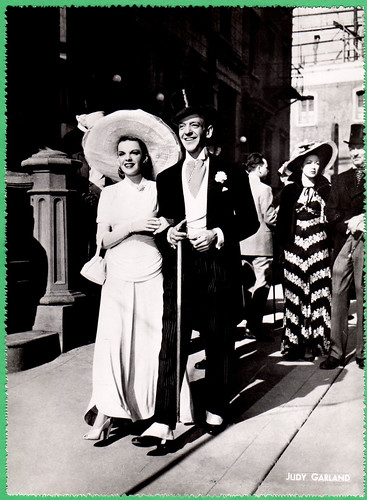
Belgian collectors card by Chocolaterie Clovis, Pepinster. Photo: Metro Goldwyn Mayer. Publicity still for Easter Parade (Charles Walters, 1948) with Fred Astaire. Collection: Amit Benyovits.
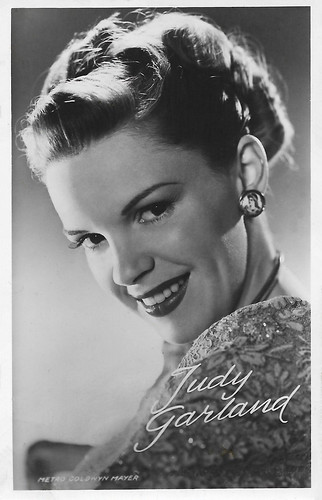
Dutch postcard, no. 3371. Photo: Metro-Goldwyn-Mayer.
Judy Garland was released from MGM in 1950, amid a series of personal struggles and erratic behaviour that had prevented her from fulfilling the terms of her contract. She signed a new film contract with Warner Bros. to star in the musical remake of A Star is Born (William A. Wellman, 1937), which starred Janet Gaynor. After filming was complete Judy was yet again lauded as a great film star. She won a Golden Globe for her brilliant and outstanding performance as nightclub singer Esther Blodgett who turned into film star Vicki Lester. But she lost out on the Best Actress Oscar to Grace Kelly for her portrayal of the wife of an alcoholic star in The Country Girl (George Seaton, 1954).
Continuing her work on stage, Judy gave birth to a son Joey Luft in 1955. She soon began to lose her millions of dollars as a result of her husband's strong gambling addiction. With hundreds of debts to pay, Judy and Sid began a volatile, on-off relationship resulting in numerous divorce filings. In 1961, at the age of 39, Judy returned to her ailing film career, this time to star in Judgment at Nuremberg (Stanley Kramer, 1961). She received an Oscar nomination for Best Supporting Actress, but this time she lost out to Rita Moreno for her role in West Side Story (Robert Wise, 1961).
Her battles with alcoholism and drugs led to Judy's making headlines in newspapers, but she soldiered on. She made record-breaking concert appearances, released eight studio albums, and hosted her own Emmy-nominated television series, The Judy Garland Show (1963–1964). In 1965, Judy and Sid finally divorced after almost 13 years of marriage. By this time, Judy, now 41, had made her final film performance alongside Dirk Bogarde in I Could Go on Singing (Ronald Neame, 1963).
She married her fourth husband, Mark Herron, in 1965 in Las Vegas. The couple separated in April 1966 after five months of marriage, owing to his homosexuality. She then settled down in London, and she began dating disk jockey Mickey Deans in December 1968. They became engaged once her divorce from Mark Herron was finalised on 9 January 1969 after three years of marriage. She married Mickey, her fifth and final husband, in Chelsea, London.
Judy Garland continued working on stage, appearing several times with her daughter Liza. It was during a concert in Chelsea, London, that Judy stumbled into her bathroom late one night and died of an accidental overdose of barbiturates, on the 22nd of June 1969 at the age of 47. The day she died, there was a tornado in Kansas.

British postcard in the Picturegoer Series, London, no. 1280. Photo: Metro-Goldwyn-Mayer. Publicity still for Love Finds Andy Hardy (George B. Seitz, 1938) with (back row) Cecilia Parker, Ann Rutherford, Judy Garland, Gene Reynolds, Lana Turner and (front row) Mary Howard, Lewis Stone, Fay Holden and Mickey Rooney.
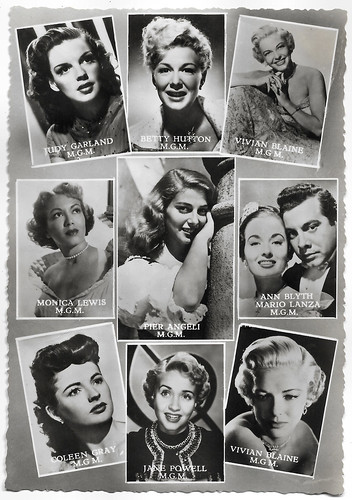
Dutch postcard by Sparo (Gebr. Spanjersberg N.V., Rotterdam). Photos: Metro-Goldwyn-Mayer. The pictured stars are Judy Garland, Betty Hutton, Vivian Blaine (twice), Monica Lewis, Pier Angeli, Ann Blyth and Mario Lanza, Coleen Gray, and Jane Powell. The postcard must date from ca. 1951, when Blyth and Lanza starred together in The Great Caruso (Richard Thorpe, 1951).
Sources: Wikipedia and IMDb.
This post was last updated on 5 May 2024.

Belgian postcard by S.A. Victoria, Brussels, no. 639. Photo: Metro-Goldwyn-Mayer.

French postcard by Editions P.I., Paris, no. 273. Photo: Metro-Goldwyn-Mayer, 1950.
An orphaned girl on a farm in the dry plains of Kansas
Judy Garland was born Frances Ethel Gumm in 1922 in Grand Rapids, Minnesota, U.S. She was the youngest daughter of vaudevillians Ethel Marion (Milne) and Francis Avent Gumm. Only two, Garland began performing in vaudeville with her two older sisters Mary Jane Gumm and Virginia Gumm as 'The Gumm Sisters'. Her family life was not a happy one, largely because of her mother's drive for her to succeed as a performer and also her father's closeted homosexuality. The Gumm family would regularly be forced to leave town owing to her father's illicit affairs with other men, and from time to time they would be reduced to living out of their automobile.
Her mother took Frances out of The Gumm Sisters act and together they travelled across America where she would perform solo in nightclubs, cabarets, hotels and theatres. In 1935, Frances was signed by Louis B. Mayer, mogul of leading film studio MGM, after hearing her sing. Her name was changed from Frances Gumm to Judy Garland, after a popular 1930s song 'Judy' and film critic Robert Garland. Tragedy followed two months later when her father died of meningitis in November 1935.
Having been given no assignments except for singing on the radio, Judy faced the threat of losing her job following the arrival of Deanna Durbin. Knowing that they couldn't keep both of the teenage singers, MGM devised a short entitled Every Sunday (Felix E. Feist, 1936) which would be the girls' screen test. Judy was the outright winner and MGM kept her. Durbin moved to Universal. Judy's film debut was in Pigskin Parade (David Butler, 1936), in which she played a teenage hillbilly.
Her career officially started when she sang one of her most famous songs, 'You Made Me Love You', at Clark Gable's birthday party in February 1937. Louis B. Mayer finally paid attention to the talented songstress, and MGM set to work preparing various musicals with her. All the work on these musicals took its toll on the young teenager, and she was given numerous pills by the studio doctors to combat her tiredness on set. Another problem was her weight fluctuation, but she was soon given amphetamines to give her the desired streamlined figure. This would produce the downward spiral that resulted in her lifelong drug addiction.
In 1939, Judy shot to stardom with The Wizard of Oz (Victor Fleming, 1939), in which she portrayed Dorothy, an orphaned girl living on a farm in the dry plains of Kansas who gets whisked off into the magical world of Oz on the other end of the rainbow. Her poignant performance and sweet delivery of her signature song, 'Over The Rainbow', earned Judy a special juvenile Oscar statuette in 1940 for Best Performance by a Juvenile Actor.

British postcard in the Picturegoer Series, London, no. 1281. Photo: Metro-Goldwyn-Mayer. Publicity still for Love Finds Andy Hardy (George B. Seitz, 1938) with Mickey Rooney, Ann Rutherford, Judy Garland and Lana Turner.

British postcard in the Picturegoer Series, London, no. 1178b. Photo: Metro-Goldwyn-Mayer.

Dutch postcard, no. 3114. Photo: MGM. Publicity still for Ziegfeld Girl (Robert Z. Leonard, Busby Berkeley, 1941) with Hedy Lamarr and Lana Turner.
A love affair between director and actress
Judy Garland was now taking an interest in men. After starring in her final juvenile performance in Ziegfeld Girl (Robert Z. Leonard, Busby Berkeley, 1941) alongside glamorous beauties Lana Turner and Hedy Lamarr, Judy got engaged to bandleader David Rose in May 1941, just two months after his divorce from Martha Raye. Despite planning a big wedding, the couple eloped to Las Vegas and married with just her mother Ethel and her stepfather Will Gilmore present. However, their marriage went downhill as, after discovering that she was pregnant in November 1942, David and MGM persuaded her to abort the baby to keep her good-girl image up. She did so and, as a result, was haunted for the rest of her life by her 'inhumane actions'. The couple separated in January 1943.
Garland made more than two dozen films with MGM, nine with Mickey Rooney. She played a vaudevillian during WWI in For Me and My Gal (Busby Berkeley, 1942). A big success was Meet Me in St. Louis (Vincente Minnelli, 1944), Director Vincente Minnelli highlighted Judy's beauty for the first time on screen, having made the period musical in colour. He showed off her large brandy-brown eyes and her full, thick lips and after filming ended in April 1944, a love affair resulted between director and actress and they were soon living together.
Vincente began to mould Judy and her career, making her more beautiful and more popular with audiences worldwide. He directed her in The Clock (Vincente Minnelli, 1945), and during filming the couple announced their engagement. On 15 June 1945 Judy and Vincente married at her mother's home with her boss Louis B. Mayer giving her away and her best friend Betty Asher serving as bridesmaid. After their honeymoon in New York, Judy discovered that she was pregnant. Her first film after marrying Vincente Minnelli was The Harvey Girls (Vincente Minnelli, 1946). Then Judy gave birth to their daughter, Liza Minnelli. After a postnatal depression, she spent much of her time recuperating in bed.
She returned to work, to film The Pirate (Vincente Minnelli, 1948) with Gene Kelly. Judy's mental health was deteriorating and she began hallucinating things and making false accusations toward people, especially her husband, making the filming a nightmare. She then teamed up with Fred Astaire for the musical Easter Parade (Charles Walters, 1948), which resulted in a successful comeback despite having Vincente fired from directing the musical. Afterwards, Judy's health deteriorated and she began the first of several suicide attempts. In May 1949, she was checked into a rehabilitation centre, which caused her much distress. After being replaced by Betty Hutton on Annie Get Your Gun (George Sidney, 1950), Judy was suspended before making her final film for MGM, Summer Stock (Charles Walters, 1950). Then Judy received her third suspension and was fired by MGM, and her second marriage was soon dissolved.
Having taken up with ruggedly handsome and streetwise entrepreneur Sidney Luft, Judy travelled to London to star at the legendary Palladium. She was an instant success and after her divorce to Vincente Minnelli was finalised on 29 March 1951 after almost six years of marriage, Judy travelled with Sid to New York to make an appearance on Broadway. With her newfound fame on stage, Judy was stopped in her tracks in February 1952 when she became pregnant by Sid Luft. At the age of 30, she made him her third husband. Her relationship with her mother had long since been dissolved by this point, and after the birth of her second daughter, Lorna Luft, on 21 November 1952, she refused to allow her mother to see her granddaughter. Ethel then died in January 1953 of a heart attack, leaving Judy devastated and feeling guilty about not reconciling with her mother before her untimely demise.

Belgian Collectors Card by Kwatta, Bois d'Haine, no. C. 101. Photo: Metro-Goldwyn-Mayer. Collection: Geoffrey Donaldson Institute.

Belgian collectors card by Chocolaterie Clovis, Pepinster. Photo: Metro Goldwyn Mayer. Publicity still for Easter Parade (Charles Walters, 1948) with Fred Astaire. Collection: Amit Benyovits.

Dutch postcard, no. 3371. Photo: Metro-Goldwyn-Mayer.
A volatile, on-off relationship resulting in numerous divorce filings
Judy Garland was released from MGM in 1950, amid a series of personal struggles and erratic behaviour that had prevented her from fulfilling the terms of her contract. She signed a new film contract with Warner Bros. to star in the musical remake of A Star is Born (William A. Wellman, 1937), which starred Janet Gaynor. After filming was complete Judy was yet again lauded as a great film star. She won a Golden Globe for her brilliant and outstanding performance as nightclub singer Esther Blodgett who turned into film star Vicki Lester. But she lost out on the Best Actress Oscar to Grace Kelly for her portrayal of the wife of an alcoholic star in The Country Girl (George Seaton, 1954).
Continuing her work on stage, Judy gave birth to a son Joey Luft in 1955. She soon began to lose her millions of dollars as a result of her husband's strong gambling addiction. With hundreds of debts to pay, Judy and Sid began a volatile, on-off relationship resulting in numerous divorce filings. In 1961, at the age of 39, Judy returned to her ailing film career, this time to star in Judgment at Nuremberg (Stanley Kramer, 1961). She received an Oscar nomination for Best Supporting Actress, but this time she lost out to Rita Moreno for her role in West Side Story (Robert Wise, 1961).
Her battles with alcoholism and drugs led to Judy's making headlines in newspapers, but she soldiered on. She made record-breaking concert appearances, released eight studio albums, and hosted her own Emmy-nominated television series, The Judy Garland Show (1963–1964). In 1965, Judy and Sid finally divorced after almost 13 years of marriage. By this time, Judy, now 41, had made her final film performance alongside Dirk Bogarde in I Could Go on Singing (Ronald Neame, 1963).
She married her fourth husband, Mark Herron, in 1965 in Las Vegas. The couple separated in April 1966 after five months of marriage, owing to his homosexuality. She then settled down in London, and she began dating disk jockey Mickey Deans in December 1968. They became engaged once her divorce from Mark Herron was finalised on 9 January 1969 after three years of marriage. She married Mickey, her fifth and final husband, in Chelsea, London.
Judy Garland continued working on stage, appearing several times with her daughter Liza. It was during a concert in Chelsea, London, that Judy stumbled into her bathroom late one night and died of an accidental overdose of barbiturates, on the 22nd of June 1969 at the age of 47. The day she died, there was a tornado in Kansas.

British postcard in the Picturegoer Series, London, no. 1280. Photo: Metro-Goldwyn-Mayer. Publicity still for Love Finds Andy Hardy (George B. Seitz, 1938) with (back row) Cecilia Parker, Ann Rutherford, Judy Garland, Gene Reynolds, Lana Turner and (front row) Mary Howard, Lewis Stone, Fay Holden and Mickey Rooney.

Dutch postcard by Sparo (Gebr. Spanjersberg N.V., Rotterdam). Photos: Metro-Goldwyn-Mayer. The pictured stars are Judy Garland, Betty Hutton, Vivian Blaine (twice), Monica Lewis, Pier Angeli, Ann Blyth and Mario Lanza, Coleen Gray, and Jane Powell. The postcard must date from ca. 1951, when Blyth and Lanza starred together in The Great Caruso (Richard Thorpe, 1951).
Sources: Wikipedia and IMDb.
This post was last updated on 5 May 2024.
No comments:
Post a Comment